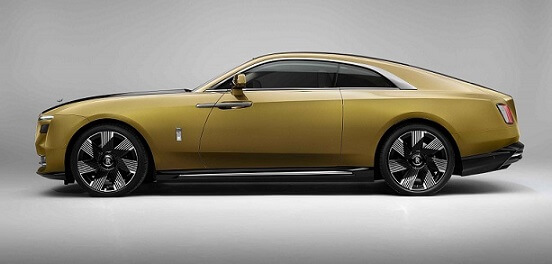Key specs
Rolls-Royce Spectre (Coupe) Spectre 2023,2024,2025
What is the body type, Rolls-Royce Spectre 102 kWh (584 Hp) AWD 2023?
Coupe, 2 Doors, 4 Seats
How fast is the car, Rolls-Royce Spectre 102 kWh (584 Hp) AWD 2023?
250 km/h 155.34 mph
How many cylinders, Rolls-Royce Spectre 102 kWh (584 Hp) AWD 2023?
Electric,
What is the drivetrain, Rolls-Royce Spectre 102 kWh (584 Hp) AWD 2023?
All wheel drive (4x4),
How long is this vehicle, Rolls-Royce Spectre 102 kWh (584 Hp) AWD 2023?
5475 mm
215.55 in.
How wide is the vehicle, Rolls-Royce Spectre 102 kWh (584 Hp) AWD 2023?
2017 mm
79.41 in.
What is the curb weight, Rolls-Royce Spectre 102 kWh (584 Hp) AWD 2023?
2890 kg
6371.36 lbs.
Rolls-Royce Spectre (Coupe) Spectre 2023,2024,2025 Specs
General information
| Brand |
Rolls-Royce |
| Model |
Spectre (Coupe) |
| Version |
Spectre |
| Engine version |
102 kWh (584 Hp) AWD |
| Year production start |
2023 |
| Vehicle type |
Coupe |
| Acceleration 0 - 100 kmh sec |
4.5 sec |
| Curb weight kg -lbs total |
2890 kg
6371.36 lbs.
|
| Overall length mm - inch |
5475 mm
215.55 in.
|
| Doors |
2 |
| Top Speed |
250 km/h 155.34 mph |
Engine specs
| Cylinders |
Electric |
| Weight / horsepower kg/hp - hp/tons |
4.9 kg/Hp
202.1 Hp/tonne
|
| Weight / torque kg/Nm - Nm/tons |
3.2 kg/Nm, 311.4 Nm/tonne
3.2 kg/Nm
311.4 Nm/tonne
|
| Fuel type |
Electricity |
| Battery |
Net capacity 102 kWh
|
| Powertrain architecture |
BEV (Electric Vehicle) |
| Electric motor power |
430kW (584 hp)
|
| Electric motor torque |
900Nm
|
| Engine location |
1 front - 1 rear
|
| Total available power |
584 Hp
|
| Totale available torque |
900 Nm 663.81 lb.-ft.
|
| Eng 56 |
Separately Excited Synchronous Motor (SSM)
|
| Eng 57 |
Front motor power 190kW / 365 Nm
|
| Eng 59 |
Charging 10-80% 195 kW (DC) max 34 minutes
|
| Eng 60 |
Charging 0-100% 22 kW (AC) 5 hours 30 minutes
|
Transmission and Drive system
| Drive configuration |
All wheel drive (4x4)
|
Brakes
| Front brakes |
Ventilated discs |
| Rear brakes |
Ventilated discs |
| Anti-lock brake system |
ABS (Anti-lock braking system) |
Steering
| Steering type |
Steering rack and pinion |
| Turning diameter m - ft |
12.7 m
41.67 ft.
|
Suspension
| Front suspension |
Double wishbone, Transverse stabilizer, Air suspension |
| Rear suspension |
Independent multi-link suspension, Air suspension, Transverse stabilizer |
| Suspension-96 |
Planar System |
Body / Chassis
| Type |
all-aluminium spaceframe
|
| Materials |
extruded aluminium sections and integration of the battery into the structure |
| Body / Chassis-106 |
Effortless Doors power-assisted system |
Wheels & Tyres
| Wheels size |
Front wheel tires: 255/40 R23
|
| Wheels rims |
23 |
Dimensions
| Overall length mm - inch |
5475 mm
215.55 in.
|
| Overall width mm -inch |
2017 mm
79.41 in.
|
| Overall height mm -inch |
1573 mm
61.93 in.
|
| Wheelbase mm - inch |
3210 mm
126.38 in.
|
| Coefficient of drag |
0.25
|
Weights
| Curb weight kg -lbs total |
2890 kg
6371.36 lbs.
|
Fuel economy
| Fuel economy-190 |
Autonomy 530km (329 miles) WLTP |
Engine type
Electric
https://www.thecarspec.com/components/engine/electric

